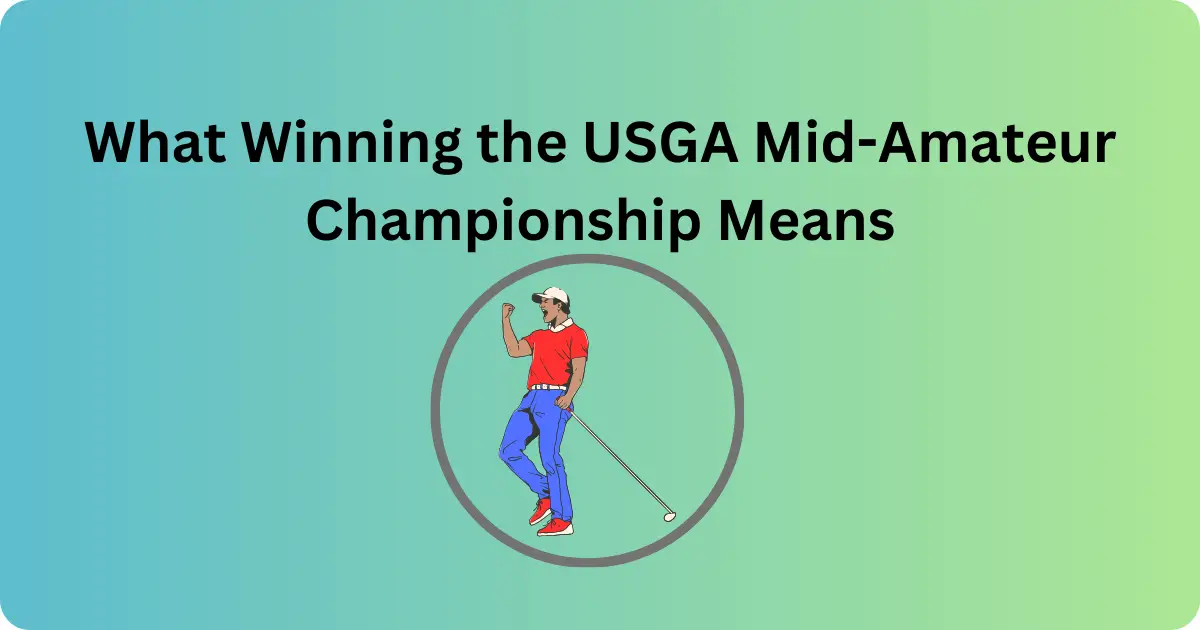Winning the USGA Mid-Amateur Championship, also called the Mid-Am, is a significant achievement for amateur golfers aged 25 and older. This vital tournament, run by the United States Golf Association (USGA), allows these players to show their skills and compete at a high level.
This guide will discuss what it means to win the USGA Mid-Am, its history, format, and the opportunities it creates for winners.
History of the USGA Mid-Amateur Championship
The USGA Mid-Amateur Championship started in 1981. It was created to give older amateur golfers a chance to compete. These players often find it hard to compete against younger, college-level golfers.
The first tournament occurred at Bellerive Country Club in Missouri, setting a strong foundation for future events. Since then, the Mid-Am has gained popularity. In1989, more than 3,000 players entered the tournament for the first time. It shows how much interest there is among amateur golfers.
The success of the Mid-Am has inspired many states to create their amateur championships.
Tournament Format: Skill and Endurance
The USGA Mid-Amateur Championship has a format that tests the skills and endurance of its players. The tournament begins with two days of stroke play. After that, the top 64 players move on to match play, where they compete head-to-head to find the champion.
This format helps ensure the winner is consistently excellent throughout the tournament. In 2001, the championship changed its final match from 18 holes to 36. This change added more challenges to the event, requiring finalists to stay focused and perform well over a more extended period.
Eligibility: Who Can Compete?
To enter the USGA Mid-Amateur Championship, players must meet specific requirements:
- They must be at least 25 years old on the tournament’s opening day.
- They must have a USGA Handicap Index of 2.4 or lower.
These rules ensure the tournament attracts skilled amateur golfers passionate about the game while balancing other life responsibilities.
The Rewards of Winning the USGA Mid-Amateur Championship
Winning the USGA Mid-Amateur Championship is a significant moment for any amateur golfer. The champion receives several vital rewards:
- A gold medal.
- The Robert T. Jones Jr. Memorial Trophy for one year.
- Invitations to future USGA events.
One of the most exciting prizes is the chance to play in the Masters Tournament, one of the four major championships in golf. This opportunity allows the winner to compete at Augusta National Golf Club, fulfilling a dream for many golfers.
Since 2018, the USGA has also given the winner an invitation to the U.S. Open. This addition increases the champion’s exposure and experience, possibly leading to a professional career in golf.
Notable Champions
Many remarkable players have won the USGA Mid-Amateur Championship and made their mark on its history:
- Jay Sigel won thrice (1983, 1985, 1987) and later played professionally on the Champions Tour.
- Nathan Smith: As a four-time champion (2003, 2009, 2010, 2012), Smith has earned multiple invitations to the Masters Tournament.
- Stewart Hagestad: A three-time champion (2016, 2021, 2023), Hagestad is well-known in amateur golf and has received invitations to prestigious tournaments.
- Matt Parziale: His 2017 victory was significant because it was the first year the winner was exempted from the U.S. Open.
The Impact of Winning
Winning the USGA Mid-Amateur Championship has many benefits that go beyond just winning a trophy:
- Recognition: The title is a significant achievement, providing recognition for amateur golfers who compete after college.
- Networking: Winners can meet other top amateurs, professionals, and influential people in the golf world, which can lead to potential sponsorships and invitations to other events.
- Personal Achievement: For many golfers, this victory validates their hard work and Winning the USGA Mid-Amateur Championship: A Coveted Achievement for Amateur Golfers
The USGA Mid-Amateur Championship is a prestigious tournament organized by the United States Golf Association (USGA) for amateur golfers aged 25 and older. This event provides a unique platform for post-college amateurs to showcase their skills and compete at the highest level.
The Impact of Winning Beyond the Golf Course
Winning the USGA Mid-Amateur Championship has far-reaching implications beyond victory’s immediate glory. It provides prestigious recognition, networking opportunities, a sense of personal achievement, and historical significance for the broader amateur golf community.
Conclusion: A Dream Worth Pursuing
Winning the USGA Mid-Amateur Championship represents the culmination of years of dedication, skill, and passion for golf. It offers amateur golfers a chance to etch their names in the annals of golf history, compete on some of the world’s most prestigious courses, and launch a new chapter in their golfing careers. For those who balance their love for the game with work and family commitments, the Mid-Am stands as a beacon of opportunity, a true golfer’s dream realized.
FAQs
What is the USGA Mid-Amateur Championship?
The USGA Mid-Amateur Championship is a prestigious golf tournament organized by the United States Golf Association for amateur players aged 25 and older.
How can I qualify for the USGA Mid-Am?
To qualify, you must be at least 25 and have a USGA Handicap Index of 2.4 or lower.
What does the winner of the Mid-Amateur receive?
The winner receives a gold medal, custody of the Robert T. Jones Jr. Memorial Trophy, and exemptions to the Masters and U.S. Open.
When was the USGA Mid-Amateur Championship first held?
The championship was first held in 1981 at Bellerive Country Club in Missouri.
Who are some notable Mid-Am champions?
Notable champions include Jay Sigel, Nathan Smith, Stewart Hagestad, and Matt Parziale, each with multiple victories and significant achievements.

James Smith is the author of a website called Golf Mentally. He believes that golf is as much about thinking as it is about swinging the club.
Golf Mentally helps golfers of all levels. It teaches new golfers the basics, like how to hold the club and hit the ball. It also helps more experienced golfers learn new things and improve their game.
James wants to help golfers think smart on the course, not just hit the ball hard. He believes that by thinking about your shots and staying positive, you can play much better golf.

